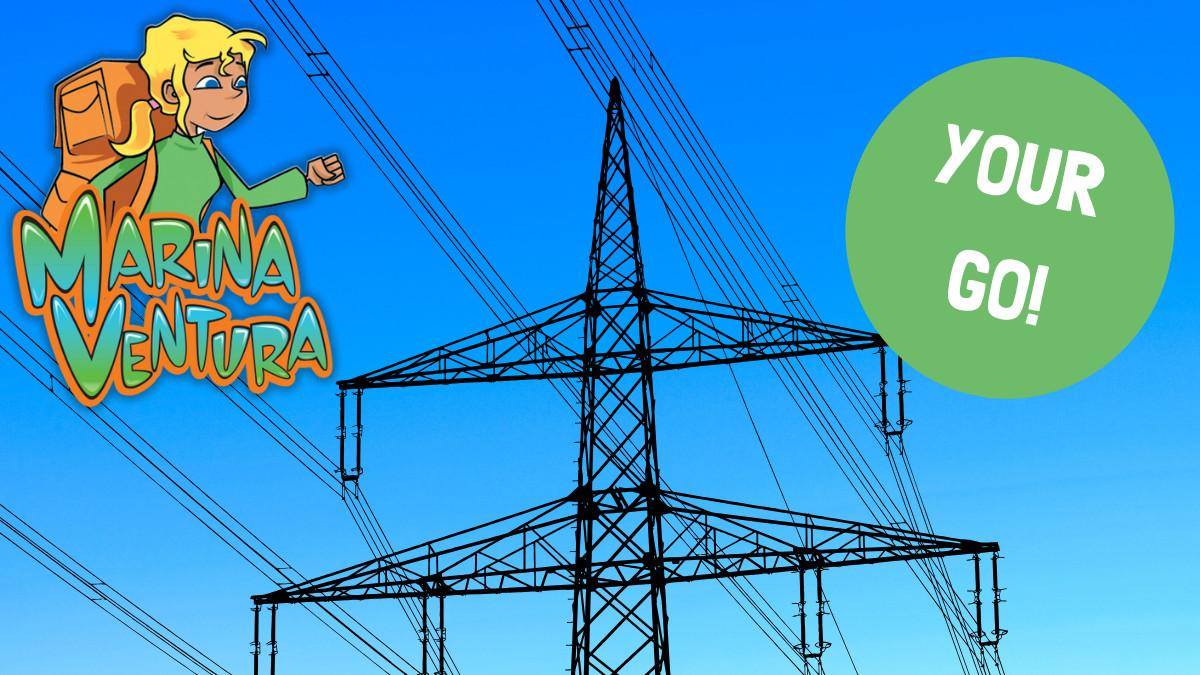
Hi guys! Marina Ventura here. Map App and I are on a mission to explore the WHAT, HOW and WHY about the pylons that help carry electricity from where it’s produced to where’s its needed.
We want your help to come up with some cool designs for an electricity pylon of the future.
There’s lots to think about – it’s design, what it’s made of and how its built. So join us as we find out what makes a perfect pylon!
We’ve been finding out a lot about pylons and now it’s over to YOU!
Are you ready to take on a challenge that combines creativity, engineering and sustainability? We want you to imagine and design a pylon of the future.
Your designs could potentially influence how the UK approaches its energy infrastructure in the years to come!
So let’s have a recap on the brief…
Design and shape
Pylons need to be strong. They get strength through their design and shape.
Whilst it might be fun to have a cow or clown shaped pylon, will that shape be strong enough to withstand heavy rain and winds as well as the baking sun?
Most pylons today are in a latticed A-frame design – which are made stronger by using triangle shaped sections.
What about the super-modern T-pylon? – that’s a different shape.
As the name suggests, T-pylons have a single pole and T-shaped cross arms which hold the cables in a diamond shape. They get their strength through the size of the pole – they are more chunkier than a lattice frame – a bit like wind turbines.

A spindly pole might blow over in a big wind. So, that’s something to think about for your design.
Also think about how your pylon design can be less intrusive or even attractive. Could it mimic natural forms like trees or blend into the environment with artistic flair?
Height
Another thing to think about is height.
They need to be tall enough to keep the cables safely away from people and wildlife, but not too high that it’s hard to maintain them.
Your pylon might need to be tall depending on what you have to cross. A wide river estuary will need very tall pylons on either side so the cables don’t tangle any ships passing underneath.
So, when creating your design, let us know what sort of environment it’s for or if it needs to cross something large or wide.
Materials
Pylons also get strength from what they’re made of, so we need to think about materials.
Most pylons are made of steel which is cheap, durable and incredibly strong and also heavy, so structures need to be strengthened so that the frame doesn’t collapse under its weight.
Future materials might be more sustainable or effective. Things like recycled plastics, aluminium or composites might be good alternatives.
Designers also need to consider weight, cost, strength, and environmental impact.
Making a model is a great way to play with materials. Paper might be too weak, whilst lolly sticks and cardboard could help give rigidity. Don’t forget that in reality your pylon needs to support a number of heavy cables. You could use wool or string to replicate these.
Some pylons have coloured glass to catch the light – so really use your imagination and include lots of colour, shapes and textures that harmonise with different landscapes — rural, urban and coastal.
Reduce carbon footprint
Finally, think about how your design can minimise its carbon footprint?
Think about the lifecycle of the materials used from manufacturing to disposal and the effect on the environment from the foundations to the future.
It’s time to start your design for a pylon of the future.
The goal is to think outside the box. Your design could be revolutionary, combining functionality with new ideas about form and materials. You can draw your design on paper or your computer. You could also build a model and send us a photo.
Click here to learn how to build a traditional lattice pylon using lolly sticks.
Top tip: To help your structure stay strong, it’s all about the bass – and I don’t mean that song! Strong wide bases can be more stable than narrow ones. You can also increase strength in your pylon by using glue, staples, paper clips or sticky tape to join materials together. Rolling folding and layering can help too!
This really is more than just a design challenge – it’s a chance to contribute ideas that might shape the future of the UK’s energy landscape. Think creatively, consider sustainability and most importantly have fun designing.
We can’t wait to see your ideas! Come on, let’s innovate for a brighter, cleaner future! Over to you!
Need some inspiration? Georgia’s designed a pylon below!
Remember to always ask a parent or guardian before filling in forms online.
Marina Ventura Energy Explorer is made with support from Grid for Good by the National Grid.








